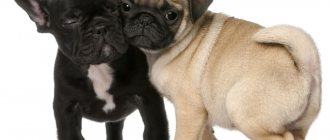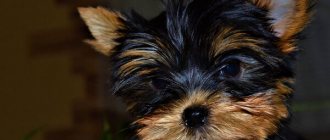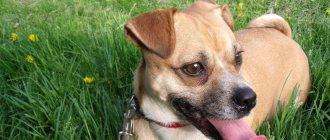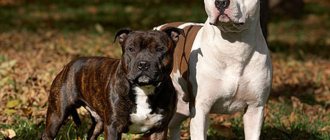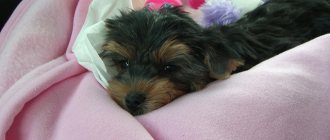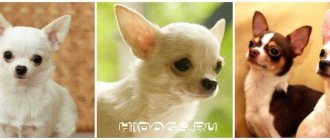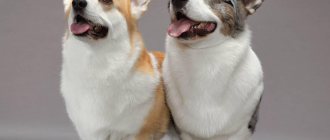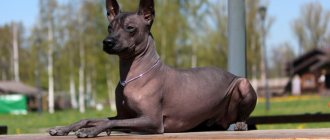A tireless search for a miniature four-legged friend will at some point certainly bring you together with a breeder of Toy Terriers or Chihuahuas. Undoubtedly, there are plenty of small dog breeds, however, these two are generally recognized as the smallest in size. Of course, there is a chance of acquiring a Mini Yorkie or Papillon, but it depends on your luck.
It is interesting that a toy terrier weighing 2 kg is no longer classified as a small dog, but officially this title is assigned to a chihuahua. Most likely, this happened due to the fact that the Russian Toy Terrier is still a fairly young breed, and the official record for miniature size was set a very long time ago.
In general terms, both breeds are extremely similar, especially their smooth-haired representatives. And if we take into account the fact that at one time it was Chihuahuas who took part in the breeding of terriers, then everything falls into place. However, despite the fact that it is not easy for inexperienced future owners to find the differences between these animals, the difference exists, and quite significant.
Characteristics of Smooth-Coated Chihuahuas and Toy Terriers
Let's start with the most similar representatives of these species - smooth-haired dogs. After all, it is they who are most often confused when trying to determine the breed of individuals.
Smooth-haired Chihuahuas are stocky and have a strong build. Their main characteristic feature (a kind of calling card) is their voluminous, rounded head, often compared to an apple. The transition from the forehead to the muzzle is clearly defined, and it itself is miniature and neat. Often, sneezes have a cute snub nose, because of which, along with large round eyes and an innocent look, their faces are given the term “baby face”.
Shorthaired Toy Terriers are sophisticated and elegant dogs. They, in comparison with sneezes, have thinner bones, the neck and paws are also noticeably longer. If you compare both dogs side by side, you will notice that the Toy is taller, while the Chihuahua has a longer body. The muzzle of this terrier is elongated, but proportional to the head, while the skull is slightly narrowed. The transition from the forehead to the nose is much less pronounced than in sneezes.
Some confusion about the differences between these breeds is caused by Toys with touching snub-nosed faces. Infrequently, but still such individuals are found: they, like the Chihuahua, have a “baby-face”-like muzzle, with all its inherent features. However, professional Toy Terrier breeders do not value the Chihuahua gene, which is responsible for such external traits. And even on the contrary, professionals avoid mating their pets with such individuals.
Toychiks also have another extreme - inheritance from terriers. And when these genes predominate in a dog, his face looks rough and rather long. In this situation, the head of a toy terrier resembles a miniature pinscher. The dog itself often has a strong build and dimensions at the upper limit of the standard: 3 kg and 28 cm.
An important difference between a Chihuahua and a Toy Terrier is color. Toys may have different coat colors, but they certainly have tan marks. The only exceptions are red and fawn colors - they are monotonous. Spotting is not acceptable on toy dogs. Unlike toys, Chihuahuas have variability in color and shades.
Description of the Chihuahua breed
Common parameters
There is no standard for Chihuahuas in the world.
Their maximum weight reaches 3 kg, minimum – 500 g . The normal figure is 2.-2.5 kg.
Breeders derived growth indicators proportional to weight. If a dog weighs less than 2 kg, its ideal height is 22-23 cm, if 2-3 kg, then 25 cm. Female Chihuahuas are slightly taller than males, and their short stature is especially valued.
Dogs have slightly apple-shaped heads and tall, wide ears that taper to a point. If the ears are not standing enough or not at all, this is considered a defect. Ear elevation in Chihuahua puppies occurs by three months.
Chihuahuas come in smooth-haired and long-haired varieties. The coat can be black, black and white, black and tan, chocolate, brindle and sable.
Pros and cons of Chihuahuas
Advantages:
- Consumes a small amount of feed;
- They have an affectionate and devoted character;
- Will not take up much space in the apartment;
- Suitable for small living space
- Do not require long walks or physical activity;
- They can go to the toilet and use the litter tray or diaper.
Flaws:
- Loud barking;
- Excessive fearlessness in front of large dogs;
- Excessive fragility;
- They treat children poorly;
- They don't remember commands well.
Character
Despite their small size, Chihuahuas have a fiery temperament, they are emotional, self-confident and overly brave, all this is manifested during walks and when communicating with other dogs. Training can correct their behavior.
Chihuahuas accept their brothers well; they are wary of representatives of other breeds..
They love their owner, but are more trusting of a woman than a man. They are also not very patient with children. Dogs do not tolerate rudeness or bad treatment; they may become offended or even bite.
It is noteworthy that long-haired Chihuahuas are more peaceful than short-haired ones . The latter are very hot-tempered.
External specifics of long-haired toy terriers and chihuahuas
Representatives of these breeds, with long hair, have much more differences from each other than smooth-haired ones. In addition to the features in the shape of the head and muzzle, which are much less noticeable in long-haired dogs, the difference between them is emphasized by the specifics of hair growth.
Chihuahua:
- the fur is evenly distributed over the body;
- undercoat is present;
- there is a nice frill and thick feathers behind the ears.
Toy Terrier:
- uneven distribution of fur, it is quite short on the body;
- no undercoat;
- Very long hair grows on the ears, hanging down like a fringe.
The elongated coat visually makes the sneeze dog more elongated and squat, and when looking at the toy dog, the visual effect of a square dog remains. The striking difference in colors also plays an important role. The white background color, which is unacceptable for Toys, is, on the contrary, desirable for Chihuahuas and looks very beautiful.
If we take into account the dimensions, then it is much easier to find a mini-dog chihuahua among long-haired chihuas than among similar toys. Despite this, both breeds fully comply with official standards and do not exceed the size of smooth-haired dogs of the same breed.
Which breed is best for keeping in an apartment?
Dogs have different temperaments, so their behavior even in the house may differ.
Toy terriers are more cheerful and active. They won't let you get bored and will cheer you up, but their activity can be annoying. Chihuahuas are more reserved.
They can lie for a long time, just watching what is happening, waiting for the owner to call them. Here the character of the owner himself also plays a role - only he can decide what kind of dog will suit him.
Otherwise the dogs are similar. They eat little, but you need to protect them from high objects and falls. They require the same amount of attention, but Toys are easier to train than Chihuahuas.
Overall, these dogs are equally suitable for apartment living. How they behave depends only on the owner.
Expert opinion Semyon Kirillovich Kozhevin Expert dog handler. Ask a question to an expert “In general, these are, of course, different breeds. It is impossible to say unequivocally who is better, but subjectively, I would choose the toy terrier because they are more active. And I don’t sit in one place either. Chihuahuas are passive for me, but for older people they are ideal, for example.”
Character and temperament
A huge, loving heart is a trait inherent in both breeds and unites them. Toy terriers, like Chihuahuas, are extremely loyal to their owners; both can become depressed due to prolonged separation from their owner. In addition, they are quite playful, curious, intelligent and equally wary of small children.
Among other things, these are fearless, brave dogs, and you need to be careful with this. The fact is that both breeds do not feel their mini sizes and can, without realizing it, put themselves in danger.
Despite such significant similarities in character, there is still a difference in temperament, and quite noticeable. For example, chikhas, in comparison with toys, are much calmer and more balanced. These dogs rarely bark “out of air” and are not prone to display aggression, unless, of course, there are serious reasons for this.
Chihuahuas are quite gentle dogs: they love attention and physical contact. They are extremely jealous, so they can get offended or, in order to shift attention to themselves, begin to push away the animal that the owner is petting in front of them. However, they do not show aggression.
Toys are incredibly dynamic animals. You could even say that the word “walk” is unknown to them. They are almost always in motion: running, jumping, rushing, flying from corner to corner. With their thin bones, such activity can be fraught with injury, especially jumping, so this breed needs to be supervised.
This terrier may be a small dog, but he considers himself a strong guard. Such a dog is very sensitive and, upon detecting a “stranger,” will bark loudly and loudly, even if the object of the disturbance is located outside the apartment. In this regard, it is better to buy a puppy, and already at this age begin to teach him to behave quietly.
As for education and training, it is much easier to conduct classes with a Chihuahua. The reason for this does not lie at all in the fact that some breed is more intelligent, it is a matter of temperament.
Toy terriers, due to their inherent hyperactivity, cannot concentrate their attention on activities, which is why they learn commands more slowly. When the training is successful and the owner is happy, the dog immediately picks up the mood, thanks to innate empathy (the ability to subtly feel the mood of another), and continuing the training again becomes difficult.
Despite some difficulties in training toys, when they manage to concentrate, they learn no worse than Chihuahuas. Both breeds grasp the rules of behavior in an apartment on the fly, just as they are sensitive to the possibility of breaking them.
Both Toy Terriers and Chihuahuas can periodically tremble from excessive excitement, cold or fear. Although trembling is inherent in Toychiks to a greater extent, because they have an active psyche and increased emotional excitability, supported by empathy. In addition, terriers are also quite sensitive to weather changes, a sort of four-legged weather station.
Who is better?
Many people ask this question when choosing a decorative pet. First of all, you must decide for yourself, because such animals are often kept due to preferences in their appearance. They do not have any special differences in care and feeding. They do not require much food and do not need to be washed or combed frequently. And in general, you won’t need much time to care for them. So, if you have always dreamed of a dwarf Doberman, then buy yourself a toy terrier. If you want a funny exotic pet, then pay attention to the Chihuahua.
The only major difference lies in their temperament, and this can be the decisive factor in making the final decision. Chihuahuas are more capricious and capricious, which can become a problem when living with other dogs or when they are usually socialized on the street. Therefore, if you want a calmer four-legged friend, then you should opt for toys.
Puppy differences
Often aware of the difference between adult Chihuahuas and Toy Terriers, inexperienced future owners are faced with worries about the ability to distinguish between their puppies. This is understandable, because, at first glance, all the kids are so similar to each other. However, after studying the information, it is easy to notice distinctive breed characteristics in puppies.
The fact is that the babies are similar to each other only in the first couple of weeks, but no one will sell you such a baby. Breeders begin to hand over Toy Terrier and Chihuahua puppies to new owners only at 2-3 months. Miniature dogs grow and develop much faster than their large relatives. By a few months, smooth-haired dogs already acquire the features of their parents, becoming their mini-copy.
By eight weeks, Toy Terrier babies stretch out and acquire elegant features, and their legs become long, like those of an adult. And only the face still remains childish in appearance. In small sneezes, the breed's peculiarity of head shape becomes noticeable quite early. Strong bones and a long body will be noticeable by the time they start selling.
Things are a little different with long-haired dogs, in which case it may be somewhat more difficult to distinguish between the breeds. For the most part, this is due to the fact that at the time of sale, such puppies will still have fairly short fur. When identifying long-haired dogs, it is worth focusing on a number of distinctive features inherent in the breeds.
Selection criteria:
- overall appearance - body build and head shape (similar to smooth-haired);
- specificity of fur growth: in the Toy Terrier litter it is still quite sparse, more reminiscent of smooth, but slightly elongated fur, the beginning “fringe” is already clearly visible on the ears; Chihuahua babies grow more evenly and are quite shaggy;
- coloring - the differences in coloring are exactly the same as in adults (described earlier).
When purchasing a Chihuahua or Toy Terrier puppy, be vigilant: if it is difficult to determine the breed by the baby’s appearance, there is a high probability that you are being deceived. Unfortunately, there are also unscrupulous sellers who can sell you a mongrel or mixed breed puppy (a cross between a sneeze and a toy) for the price of a purebred.
In addition, this may be a terrier with a pronounced Chihuahua gene - as discussed at the beginning of the article - or the baby is so small (up to 1.5 months) that the external characteristics of the breed have not yet appeared.
So, who is better: a chihuahua or a toy terrier?
Unfortunately (or fortunately), this question does not have a clear answer. Both breeds are good in their own way: each has its own advantages and disadvantages. Both have their own connoisseurs and admirers. As they say, it depends on the taste and color...
However, if after reading the article, you still couldn’t choose who to give preference to, but you really want to make one of these four-legged friends - we’ll try to make the task easier for you.
Answer these questions honestly:
- Do you like tranquility, not accepting noise and bustle?
- Do you have any small children living with you?
- An active lifestyle is not for you or is it “not the right age”?
- Do you want a gentle creature always spinning around you, which you can pet endlessly?
Having answered all or most of the questions “Yes”, you have chosen a Chihuahua; if “No” predominates, you have chosen a Toy.
The Chihuahua will be an excellent companion for older people or lovers of a calm, measured life. Very affectionate and gentle, he will not get off his lap. Sneezes are so loving that your pets will literally follow you around.
The toy terrier is a great friend and companion for active games with children. Remember that although Toys love to bark, calm behavior in this regard can be taught to them from childhood. This little “motor” will never let you get bored.
When purchasing a particular breed of mini-dog, it is necessary to take into account the temperament of the pet already living in the apartment (if there is one, of course). For the agile Yorkshire Terrier, the Toy will be an ideal buddy. Papillon and Shih Tzu will share the owner's lap with a sneeze, not without pleasure. Both mini-breeds will get along great with a massive, good-natured dog. However, remember that dogs of the same breed will best understand each other.
Whoever you choose, be it a Chihuahua or a Toy Terrier, always remember: despite their miniature and toy appearance, these are living creatures that require attention and care. Never own an animal for fun, because we are responsible for those we have tamed.
Comparison of breeds by other criteria
Toy terriers differ in coat type, Chihuahuas in physiological characteristics: cobby and dir.
Both dogs grow up by the age of one year, but if large breed puppies are three months old, then it is better to adopt a Chihuahua at 6-8 months. At this age, all defects, as well as their character, will already be noticeable.
IMPORTANT!
The life expectancy of Chihuahuas is longer than that of toy terriers - 14-18 years, and that of toys - 10-12.
Also, toy terriers quickly adapt to a new environment when moving. Chihuahuas need to be given attention so that they do not withdraw into themselves, become nervous and aggressive.
Both dogs do not tolerate loneliness well, both are loyal to their owners.
Toys are more active and show aggression towards strangers. Chihuahuas are calm in this regard; they react coldly and warily to new people.
